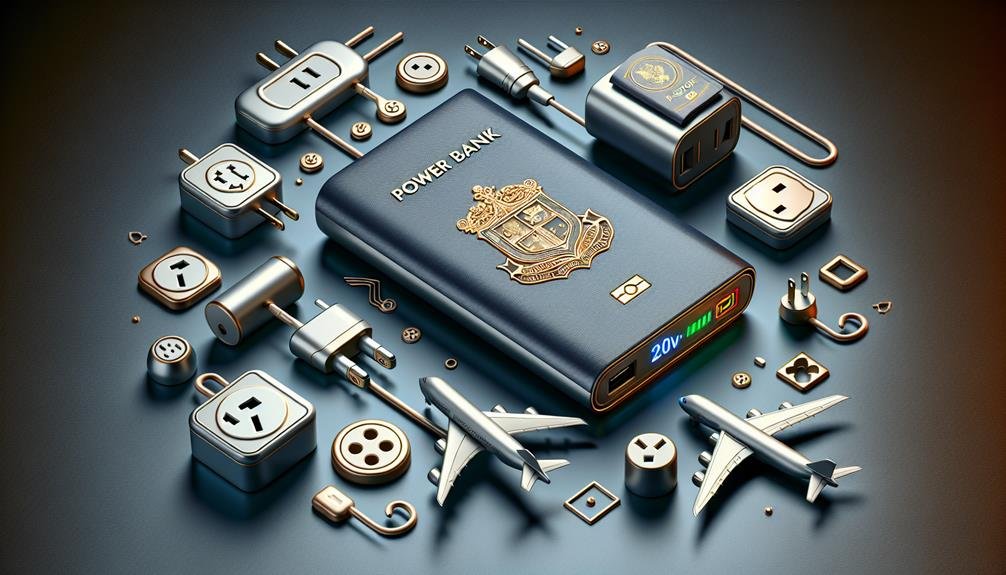Anker power banks are indeed dual voltage, supporting input ranges from 100-240V. This guarantees seamless compatibility with global electrical standards, making them ideal for international travel. Their advanced circuitry automatically adjusts to the appropriate voltage level, mitigating risks of damage or hazards. High-capacity models often feature multiple output ports like USB-A, USB-C, and micro-USB, integrating technologies like PowerIQ and VoltageBoost for efficient, rapid charging. Always review specific model datasheets for detailed voltage compatibility and safety features like surge protection and temperature control. There's more to explore, especially regarding practical usage and comparative insights.
What Is Dual Voltage?

Dual voltage refers to the capability of a device to operate on two different voltage levels, typically 110-120V and 220-240V, allowing for versatile use across various electrical systems globally. This functionality is essential when you're traveling internationally, as it guarantees compatibility with different electrical standards, reducing the risk of damage to your device or electrical hazards.
When evaluating power bank features, understanding dual voltage is crucial. A power bank with dual voltage capabilities can seamlessly adapt to varying input voltages, guaranteeing reliable and safe charging of your devices, irrespective of the local power grid specifications. This adaptability is facilitated by advanced circuitry that automatically detects and adjusts to the appropriate voltage level, thereby safeguarding against potential overvoltage or undervoltage conditions.
Compliance with electrical standards is another vital aspect. Devices adhering to international electrical standards undergo rigorous testing to ensure they meet safety and performance benchmarks. For a power bank, these standards might include certifications like CE, FCC, or UL, which signify that the product has been evaluated for safety, electromagnetic compatibility, and overall reliability. By choosing a dual voltage power bank, you're prioritizing the safety and longevity of your electronic devices, ensuring they receive consistent and appropriate power, no matter where you are.
Anker Power Bank Basics
When considering Anker power banks, you'll need to evaluate charging capacity options, which range from compact 10,000mAh units to high-capacity 26,800mAh models. Additionally, port compatibility is pivotal; these power banks typically feature multiple output ports including USB-A, USB-C, and sometimes micro-USB for versatility. Understanding these specifications guarantees peak device compatibility and efficient power management.
Charging Capacity Options
Anker power banks offer different charging capacities, ranging from compact 5,000mAh models for quick top-ups to high-capacity 26,800mAh units capable of multiple device recharges. When comparing charging capacities, it's crucial to assess your specific needs. Smaller power banks, like the 5,000mAh models, are lightweight and easily portable, ideal for short trips or emergency use. Conversely, the 26,800mAh units provide extensive power, suitable for extended travel or multiple device usage.
Concerning battery life enhancement, Anker's advanced circuitry guarantees efficient energy transfer, maximizing the usable lifespan of both the power bank and your devices. High-capacity models often include multiple output ports, allowing simultaneous charging, which can be crucial in multi-device scenarios. However, it's noteworthy that higher capacity units are larger and heavier, which might impact portability.
Charging speed analysis highlights Anker's integration of PowerIQ and VoltageBoost technologies, which dynamically adjust output to provide the quickest possible charge. This reduces downtime and improves overall efficiency. For safety, Anker power banks incorporate surge protection, short-circuit prevention, and temperature control, ensuring dependable and secure operation in all charging situations. Prioritize your requirements to choose the most suitable power bank size and capacity for your needs.
Port Compatibility Overview
Understanding port compatibility in Anker power banks is crucial for guaranteeing seamless connectivity with a diverse range of devices, encompassing both legacy and modern interfaces. The power bank sizing and port availability are critical factors that determine how adaptable your power bank is to various gadgets, guaranteeing device compatibility and safety.
Anker power banks typically feature a mix of USB-A, USB-C, and micro-USB ports. USB-C ports, known for their high-speed data transfer and charging capabilities, offer superior adaptability for modern devices. USB-A ports provide broad compatibility, accommodating older devices that still rely on this standard. Micro-USB ports, though increasingly obsolete, ensure you can charge legacy equipment without additional adapters.
| Port Type | Device Compatibility |
|---|---|
| USB-C | Modern smartphones, tablets, laptops |
| USB-A | Older smartphones, cameras, miscellaneous gadgets |
| Micro-USB | Legacy devices, older accessories |
| Multi-Port | Versatile, supports simultaneous charging |
When selecting an Anker power bank, scrutinize the port availability relative to your device ecosystem. Match the power bank sizing to your usage needs—larger capacities often come with more ports, enhancing adaptability. Guarantee that the power bank you're considering has safety certifications, like CE or FCC, to prevent electrical hazards. By thoroughly understanding port compatibility, you maximize both functionality and safety.
Voltage Needs for Travelers
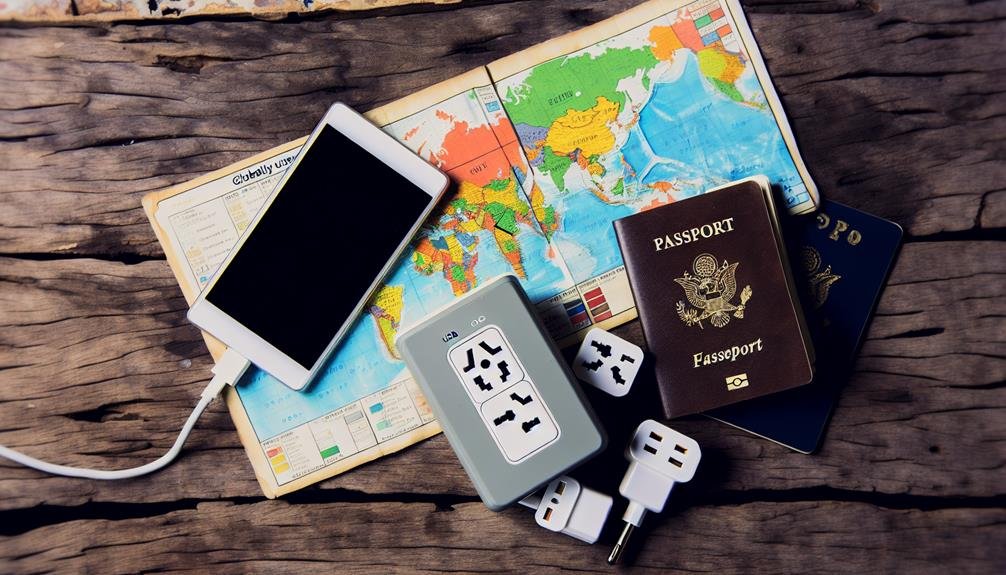
When you're traveling internationally, global voltage compatibility is critical to guarantee your devices charge efficiently without damage. Anker's dual voltage power banks offer the flexibility to support various regional electrical standards, minimizing the risk of incompatibility. Additionally, these power banks can simultaneously charge multiple devices, optimizing your power management on the go.
Global Voltage Compatibility
Given the diverse voltage standards across different countries, travelers must confirm their power banks are equipped for global voltage compatibility to avoid any disruptions in device charging. Anker power banks, designed with international standards in mind, often feature wide-ranging voltage input capabilities, typically accommodating 100-240V. This range ensures that whether you're in North America with a standard 110V or Europe with 220V, your power bank will function seamlessly.
However, you'll need to take into account voltage converters and travel adapters. While most Anker power banks support dual voltage, the chargers and outlets in different regions may not. A voltage converter is essential if your charger isn't dual voltage, converting the local electricity to the appropriate level. Travel adapters, on the other hand, ensure physical compatibility between your charger plug and the foreign outlet.
Adhering to power bank regulations and international standards is crucial to prevent safety hazards such as overheating or short-circuiting. Always check the specifications on your Anker power bank and charger before traveling. Ensure they comply with regulations in your destination country to maintain peak performance and safety. This meticulous attention to detail will secure your devices remain charged without compromising safety.
Charging Multiple Devices
Travelers often need power banks with multiple output ports to efficiently manage the voltage needs of charging multiple devices simultaneously. When you're on the go, it's important to make sure that your power bank supports device compatibility and power efficiency. Anker power banks are engineered with advanced circuitry to provide the best charging speed while safeguarding battery lifespan.
| Feature | Description |
|---|---|
| Multi-Port Output | Simultaneously charges multiple devices. |
| PowerIQ Technology | Ensures device compatibility and efficient power delivery. |
| Voltage Regulation | Maintains stable voltage to protect battery health. |
When charging multiple devices, it's crucial to balance the power distribution. Anker's MultiProtect safety system integrates surge protection, short circuit prevention, and more to guarantee the safe operation of your devices. The PowerIQ technology dynamically adjusts the output to match the connected device, optimizing charging speed without compromising battery lifespan.
Choosing an Anker power bank with dual voltage capability means you can use it in various international locales without worrying about voltage incompatibility. Always confirm the voltage specifications of your devices to prevent overloading or undercharging.
Checking Voltage Compatibility
To verify your Anker power bank is compatible with different voltage requirements, you must check the device's specifications for dual voltage support and appropriate input/output ratings. Primarily, scrutinize the power bank's datasheet or user manual for voltage conversion capabilities. This guarantees that the device can handle varying voltage levels, particularly if you plan to use it internationally or with multiple devices requiring distinct voltage inputs.
Next, examine the power output ratings, typically expressed in volts (V) and amperes (A). Make certain that the power bank can deliver the necessary voltage and current for your devices. For instance, if your device requires a 5V/2A input, the power bank should match or exceed this specification without causing damage or underperformance.
Safety is paramount; hence, verifying these ratings prevents potential hazards such as overheating, overcharging, or electrical malfunctions. Look for built-in safety features like voltage regulation, over-charge protection, and short-circuit prevention mechanisms. These features are essential to maintain the longevity and reliability of both the power bank and your devices. Remember, meticulous attention to voltage compatibility guarantees seamless, risk-free operation across diverse electrical environments.
Anker's Official Specifications
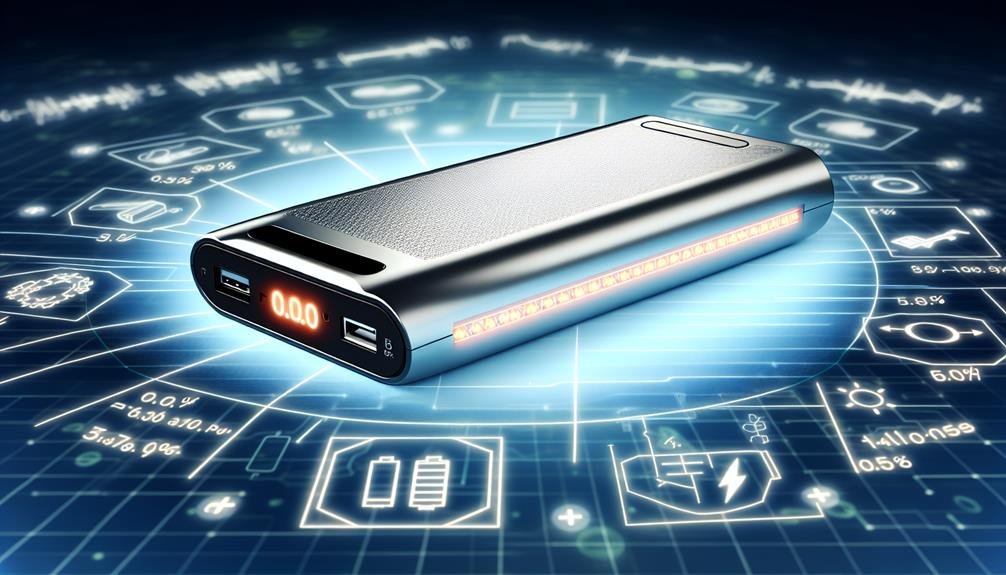
After confirming voltage compatibility, it's essential to examine Anker's official specifications to verify the power bank's performance metrics and built-in safety features. Thoroughly understanding these specs is critical for best usage and safeguarding your devices.
Anker power banks are designed with advanced voltage conversion technology, guaranteeing efficient power output for various devices. The charging speed directly correlates with the power output, typically measured in watts. Higher power output results in faster charging speeds, reducing downtime for your devices. Nonetheless, the battery life of the power bank itself is also a key consideration. Battery life is influenced by the capacity, usually measured in milliampere-hours (mAh), and the efficiency of the internal circuitry.
Below is a table summarizing key specifications for popular Anker models:
| Feature | Anker PowerCore 10000 | Anker PowerCore+ 26800 |
|---|---|---|
| Voltage Conversion | 5V/2.4A | 5V/3A, 9V/2A, 15V/1.2A |
| Power Output (Watts) | 12W | 30W |
| Battery Life (mAh) | 10,000 | 26,800 |
Equipped with MultiProtect safety systems, Anker guarantees protection against overcharging, overheating, and short circuits. These features provide peace of mind when using their power banks, ensuring reliable performance while preserving the longevity of your devices.
User Experiences and Reviews
User feedback on Anker power banks frequently highlights their robust voltage efficiency, fast charging capabilities, and the reliability of MultiProtect safety features. Users often emphasize how these power banks maintain consistent voltage output, ensuring your devices receive the best current flow without risk of overvoltage. This efficiency is vital for safeguarding your electronics, providing peace of mind when charging sensitive devices.
Moreover, quick charging capabilities are a recurring point of user satisfaction. Anker's integration of PowerIQ and VoltageBoost technologies ensures that your devices charge swiftly and safely. These features dynamically adjust the power output to match the connected device's needs, reducing charge times significantly while maintaining product reliability.
In terms of safety, the MultiProtect safety system is a standout feature in user reviews. This suite of safety mechanisms includes temperature control, surge protection, and short-circuit prevention. Users consistently praise these features, noting that they enhance the overall reliability of the product and provide an added layer of security during use.
Comparing Different Models
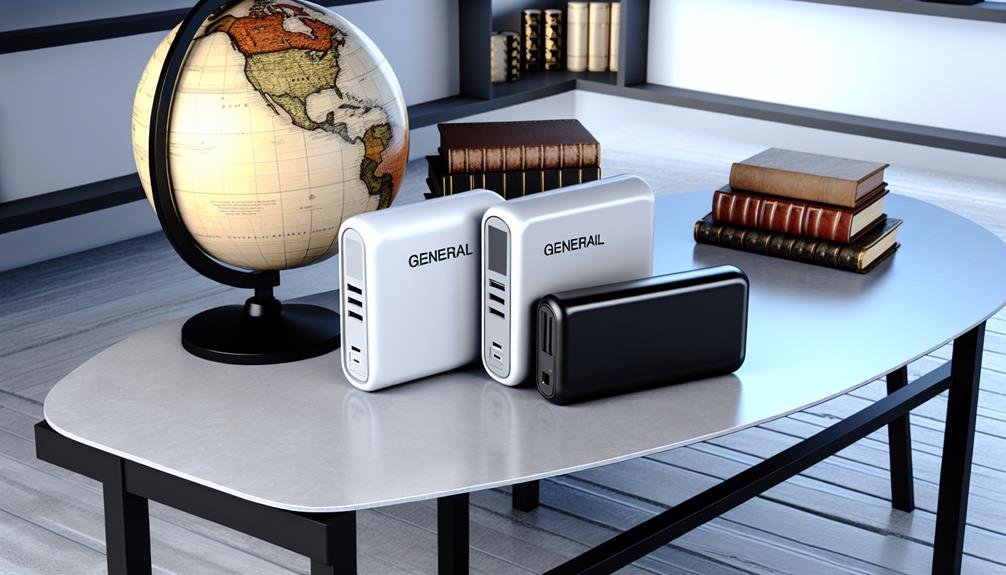
When comparing different Anker power bank models, examining specifications such as battery capacity, output ports, and supported charging technologies is essential to determine which device best suits your requirements. You'll find that the dual voltage benefits of these power banks can greatly enhance their versatility, especially if you have multiple devices with varied power needs.
Here's a comparison table highlighting key features of three popular Anker models:
| Feature | Anker PowerCore 10000 | Anker PowerCore 20000 | Anker PowerCore+ 26800 |
|---|---|---|---|
| Battery Capacity | 10,000mAh | 20,000mAh | 26,800mAh |
| Output Ports | 1 USB-A | 2 USB-A | 3 USB-A, 1 USB-C |
| Charging Technologies | PowerIQ | PowerIQ, VoltageBoost | PowerIQ, VoltageBoost, Quick Charge 3.0 |
When examining battery life comparison, the PowerCore 10000 offers a compact solution with sufficient longevity for basic needs. The PowerCore 20000, with its dual ports and enhanced capacity, ensures prolonged usage times. The PowerCore+ 26800, incorporating Quick Charge 3.0, is ideal for high-demand scenarios, offering impressive battery longevity and rapid recharging capabilities.
For safety-conscious users, Anker's MultiProtect safety system, which safeguards against overcharge, short circuits, and temperature fluctuations, is standard across all models, guaranteeing reliable and secure operation.
Charging Internationally
Understanding the dual voltage capabilities of Anker power banks is vital for seamless international charging, guaranteeing your devices receive the correct voltage regardless of regional differences. When traveling abroad, you'll encounter varying electrical standards, typically 100-127V in North America and 220-240V in most other regions. Anker power banks, being inherently dual voltage, mitigate these discrepancies, facilitating consistent and reliable charging.
You must, however, consider the necessary hardware to bridge these regional differences. International adapters are indispensable for fitting foreign plug configurations. While Anker power banks efficiently handle dual voltage, they still require the correct plug type to interface with international sockets. Failure to use appropriate international adapters could result in improper connections and potential damage.
Moreover, voltage converters are essential when dealing with devices that aren't dual voltage-compatible. Although Anker power banks generally support dual voltage, the devices they charge might not. A voltage converter guarantees that any single-voltage device can safely interface with the local electrical supply, preventing overvoltage risks and ensuring device longevity.
Safety Considerations
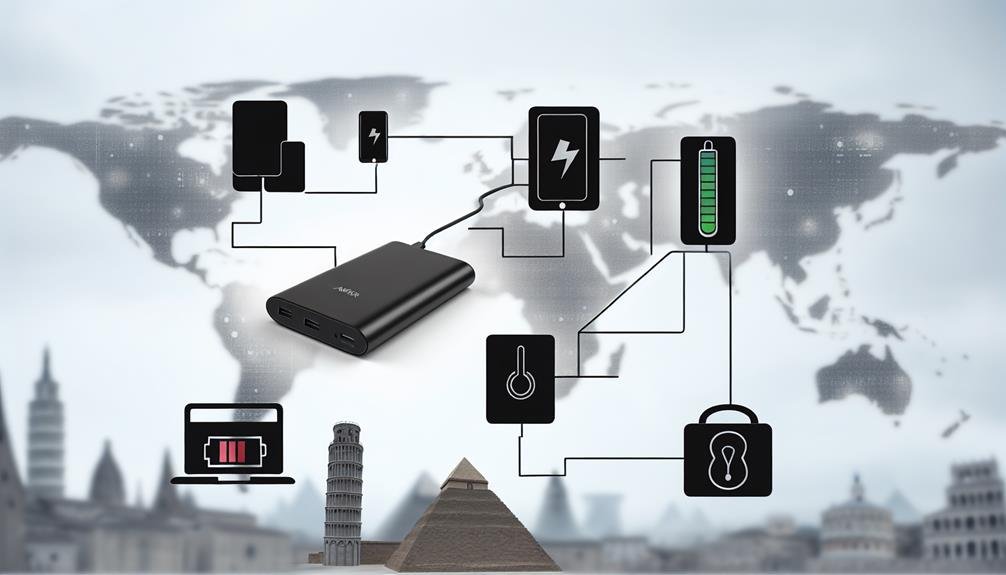
Maintaining the safe operation of Anker power banks involves careful attention to overheating prevention, proper handling of lithium-ion batteries, and adherence to manufacturer guidelines. Voltage safety is essential; always confirm that the input and output voltages align with the specifications of your devices. Anker's dual voltage advantages offer flexibility but require caution. Dual voltage technology allows for compatibility with various devices, but improper use can result in short circuits or device damage.
To prevent overheating, avoid exposing the power bank to extreme temperatures and ensure sufficient ventilation during charging. Lithium-ion batteries, while efficient, pose risks if mishandled. Regularly check for any signs of swelling, leaks, or unusual odors, and discontinue use if any abnormalities are detected. Adherence to manufacturer guidelines is vital—use only the provided cables and avoid third-party accessories that may not meet safety standards.
Incorporating dual voltage advantages into your usage routine requires understanding the specific voltage requirements of your devices. This guarantees compatibility and prevents electrical hazards. By maintaining strict standards for voltage safety and battery care, you can maximize the lifespan and reliability of your Anker power bank, protecting both your devices and personal safety.
Future Trends in Power Banks
You'll see future power banks incorporating advanced wireless charging capabilities, reducing dependency on physical connectors. Enhanced battery efficiency is another critical trend, leveraging innovations in energy density and thermal management to offer extended usage periods. These advancements will redefine portability and convenience in mobile power solutions.
Wireless Charging Capabilities
In the evolving landscape of power bank technology, wireless charging capabilities represent a significant advancement, driven by innovations in Qi standards and electromagnetic induction techniques. When considering charging speed, it's crucial to note that wireless compatibility with various devices can influence the efficiency of power transfer. Anker's power banks, for instance, employ cutting-edge technology to ensure peak charging speeds, balancing between output power and thermal management to safeguard device integrity.
Battery life is another important consideration. Wireless charging, while convenient, can slightly diminish overall battery longevity due to heat generation. Anker mitigates this by incorporating advanced thermal regulation systems, ensuring that both the power bank and your devices remain within safe operational temperatures. Additionally, Anker's compact design philosophy ensures that these power banks remain portable without sacrificing performance or durability.
Moreover, when selecting a wireless charging power bank, it's vital to check for Qi certification to guarantee compatibility and safety. Anker's commitment to adhering to stringent safety standards ensures that their wireless chargers provide reliable and efficient power delivery. By understanding these technical nuances, you can confidently choose a power bank that not only meets your charging needs but also prioritizes safety and longevity.
Enhanced Battery Efficiency
Advancements in battery efficiency are poised to revolutionize the power bank industry, driven by innovations such as solid-state batteries, improved energy density, and intelligent power management systems. Solid-state batteries, with their higher ionic conductivity and thermal stability, offer a promising avenue for enhanced safety and longevity. These batteries mitigate the risk of leakage and thermal runaway, ensuring a safer user experience.
Energy conservation is another pivotal factor. Modern power banks are integrating intelligent power management systems that dynamically adjust the power output to match the device's requirements, thereby minimizing energy wastage. This not only enhances battery life but also contributes to a more sustainable usage pattern.
Improved energy density, achieved through advancements in electrode materials and electrolytes, allows for more compact and lighter power banks without compromising on capacity. This translates to longer-lasting charges and reduced need for frequent recharges, aligning perfectly with the demands of modern, on-the-go lifestyles.
Frequently Asked Questions
How Long Do Anker Power Banks Typically Last on a Full Charge?
Anker power banks, dependent on battery capacity and charging speed, typically last 3-7 days on a full charge. Charging multiple devices can reduce the power bank lifespan, requiring careful energy management to maintain peak performance and safety.
Are Anker Power Banks Compatible With Apple Devices?
Anker power banks are incredibly efficient, delivering lightning-fast charging speed for Apple devices. They're designed with universal compatibility, seamlessly supporting both iOS and Android. Your devices will always be safe, thanks to advanced safety mechanisms.
Can Anker Power Banks Charge Laptops?
Yes, Anker power banks can charge laptops. Confirm laptop compatibility by checking voltage output and power bank capacity. Anker's high-capacity models, such as the PowerCore+ series, provide strong charging capabilities, guaranteeing efficient and safe laptop charging.
What Is the Warranty Period for Anker Power Banks?
Warranty coverage for Anker power banks typically totals 18 months. If you need to initiate a claim process, their customer service is superb, offering efficient repair options. Your safety is paramount, ensuring reliable and robust protection.
Do Anker Power Banks Come With USB-C Ports?
Yes, Anker power banks often feature USB-C ports, providing fast charging and compatibility with various devices. They offer high power output, enhancing charging speed while adhering to strict safety standards to protect your devices efficiently.

